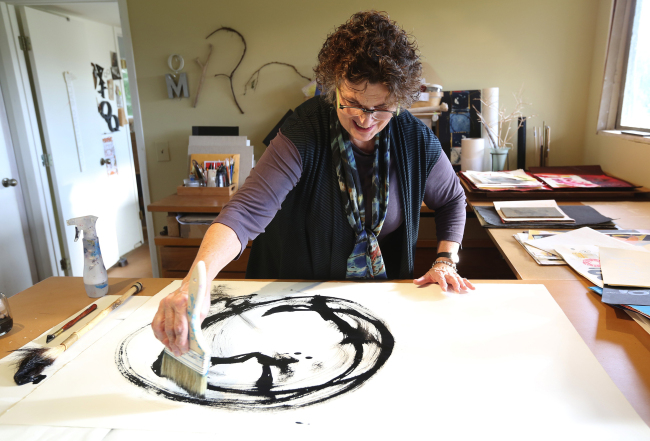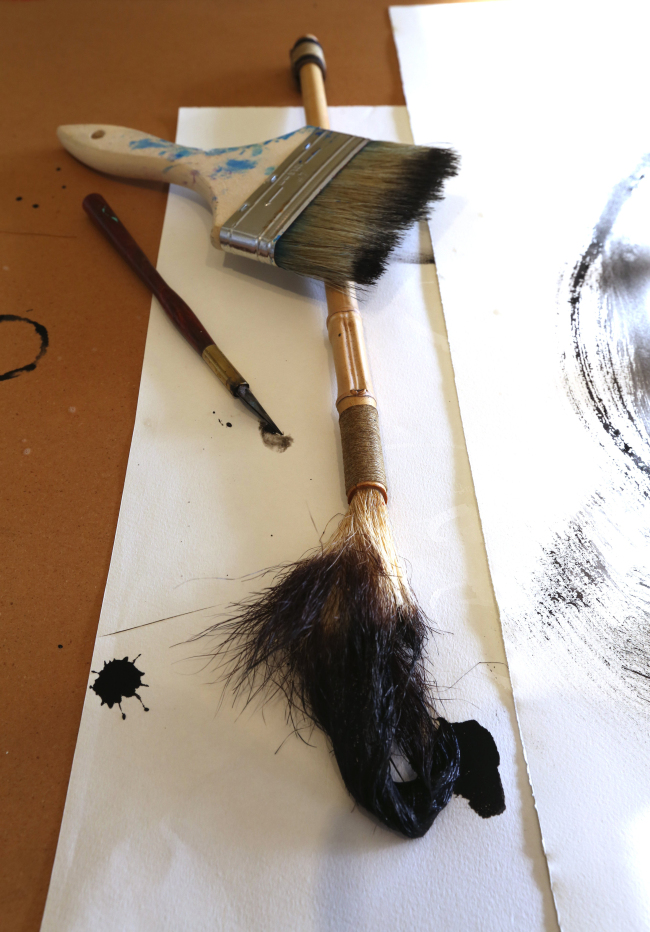Handmade St. John’s Bible unique opportunity, challenge
By Korea HeraldPublished : Jan. 15, 2015 - 21:08
In our image-bombarded world, one-of-a-kind creations are hard to find. Paintings and sculptures, maybe. But digital media ― smartphones, e-readers, tablets ― have made the world of words an infinitely expanding universe.
Vashon Island bookmaker, artist and calligrapher Suzanne Moore has been swimming against this tide for most of her career. She makes manuscripts, lettering them by hand, illustrating them and then turning them over to her husband and an assistant to bind. Collectors buy them. Sometimes they commission them.
When, in the late 1990s, Moore was one of two American artists chosen to participate in the creation of The Saint John’s Bible, a 1,150-page illuminated Bible made from vellum (calfskin), hand-ground paints, ancient inks and quills, she was thrilled, and a little awed.
Vashon Island bookmaker, artist and calligrapher Suzanne Moore has been swimming against this tide for most of her career. She makes manuscripts, lettering them by hand, illustrating them and then turning them over to her husband and an assistant to bind. Collectors buy them. Sometimes they commission them.
When, in the late 1990s, Moore was one of two American artists chosen to participate in the creation of The Saint John’s Bible, a 1,150-page illuminated Bible made from vellum (calfskin), hand-ground paints, ancient inks and quills, she was thrilled, and a little awed.

“It was the hardest and most challenging thing I’ve ever done,” Moore remembers. She creates alone ― “I put it out in the world, and there’s one collector who wants to have it in their collection. I don’t have a committee, and I don’t have an art director. The idea of this big far-flung community making this one book was just ... larger than life.”
Today, Moore’s illustrations lie within the pages of the original Saint John’s Bible, on display at the Hill Museum & Manuscript Library on the campus of Saint John’s University in Collegeville, Minnesota. “Heritage Editions,” fine-art replicas of the original, have been acquired by institutions including Yale University, the Mayo Clinic, the Vatican Library, and Gonzaga University in Spokane.
The story of the Saint John’s Bible is one of inspiration, collaboration and tenacity. Saint John’s Bible representative Brad Neary calls it a “Bible for the 21st century” for its ecumenical spirit and emphasis on modern sensibilities.
But it’s a Bible with very ancient antecedents.
It was the brainchild of Donald Jackson, another artist with a one-of-a-kind job. Jackson’s official title is “scribe and calligrapher to the Crown Office of United Kingdom of Great Britain and Northern Ireland.” Official scribe to the Queen, in other words. He has his own scriptorium in Wales.

In the 1990s, Jackson, looking for support for his vision of a hand-lettered, hand-illuminated Bible, began talks with representatives of Saint John’s University and Saint John’s Abbey, a Benedictine monastery on the college campus, about 150 kilometers northwest of Minneapolis-St. Paul.
The college and the abbey agreed to commission the Bible. The projected price tag was $3 million; like many grand visions, the final cost would be much more ― $8 million, raised primarily through donations.
Jackson assembled a team of scribes in England. He created an original script for the Bible, which each scribe had to learn to replicate to Jackson’s exacting specifications.
“I could not have been one of the scribes,” says Moore. “They had to make the texture and the weight and the pattern of the lettering look continuous.”
And Jackson put a call out to artists worldwide to join him in creating the “illuminations,” the combination of paintings and script inspired by specific chapters and verses.
Jackson had seen one of Moore’s unique books devoted to the alphabet created by Sequoia, the Cherokee Indian chief. He invited her to participate. She traveled to Wales and did a weeklong audition. But when he offered her work on the project, she had taken a full-time job in Cleveland, Ohio, and had to say no to his offer of lodging on his Wales property while she worked on the Bible.
“Every calligrapher in the world wanted this,” Moore says. “I said to Donald, I have to balance the books, for my family. If you can use me any other way, working long distance, you’re on.” He agreed to let her work remotely, and she started on her assignments while in Cleveland, continuing the project after moving to the Seattle area in 2005. The Bible was completed in 2011.
The Bible’s narrative was created thousands of years ago, by many different writers, and scriptural passages have generated thousands of years’ worth of argument. Moore relied on the Saint John’s Committee on Illumination and Text, composed of theologians, biblical scholars, artists, lay people and others, to interpret the text she was charged with illustrating. “Sometimes it was a paragraph, and sometimes it was a page,” she says. “I couldn’t have done it without it. I had a light-handed Christian upbringing, but there was so much I didn’t know.”
The committee wanted an ecumenical approach, so she was encouraged to draw imagery from different spiritual traditions. For example, Donald Jackson’s illumination, “Geneaology of Jesus,” includes names in English, Hebrew and Arabic.
The price of one of the 300 seven-volume “Heritage Edition” sets, reproduced to Jackson’s exacting standards on fine cotton paper instead of vellum, is $155,000 (a “trade” edition is available for $385, and individual volumes are available in the $50 range on Amazon).
Saint John’s has broadened the Bible’s exposure through its “A Year with the Saint John’s Bible” program. In August, Epiphany Episcopal Church in Seattle completed a year hosting the books of the Pentateuch (the first five books of the Bible, also the Torah in the Jewish religion), the Gospels and Acts.
The Rev. Doyt Conn Jr., rector of Epiphany, says the Bible made a powerful statement in Epiphany’s services. As it was read in the congregation’s midst, it had a “gravitas,” Conn says.
“It was an outward and visible manifestation of what we believe about the Bible and about Jesus,” he says. “It was big, it was burly, it was awkward to move, it became an outward and visible sign of how we wrestle with the Scripture.”
“This book is so big that when you get close to it, you’re inside of it,” says Moore. “It extends almost to the edges of your peripheral vision. You have to approach it in a different way from a painting. It enfolds you.”
The church made it available to whoever wanted to see it. “People who were not part of our church, who weren’t even Christians, for that matter, came through to look at it,” Conn recalls.
Whether you are religious or not, viewing this Bible (this writer saw a volume of the Heritage Edition) is an experience. The calligraphy, shaped by the hands of the world’s finest scribes, working with goose or swan quills. The inspired art. The feeling of stillness, as you view a hand-lettered treasure, much as pilgrims did thousands of years ago.
For Moore, it was the experience of a lifetime, all the sweeter for having worked in collaboration with Jackson and people who shared his vision. She is particularly proud of her illumination called “The Calming of the Storm,” based on a biblical passage in which Jesus calms the waters of the Sea of Galilee. “It’s a tiny little painting, relative to other pieces I have done ... but I think that particular painting is the best I have done in my entire life.”
By Mary Ann Gwinn
(The Seattle Times)
(Tribune Content Agency)
-
Articles by Korea Herald


![[Exclusive] Korean military set to ban iPhones over 'security' concerns](http://res.heraldm.com/phpwas/restmb_idxmake.php?idx=644&simg=/content/image/2024/04/23/20240423050599_0.jpg&u=20240423183955)

![[Graphic News] 77% of young Koreans still financially dependent](http://res.heraldm.com/phpwas/restmb_idxmake.php?idx=644&simg=/content/image/2024/04/22/20240422050762_0.gif&u=)



![[Pressure points] Leggings in public: Fashion statement or social faux pas?](http://res.heraldm.com/phpwas/restmb_idxmake.php?idx=644&simg=/content/image/2024/04/23/20240423050669_0.jpg&u=)










